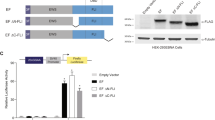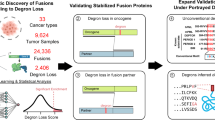Abstract
Malignant transformation of human cells requires the accumulation of multiple genetic alterations, such as the activation of oncogenes and loss of function of tumor suppressor genes or those related to genomic instability. Among the genetic alterations most frequently found in human tumors are chromosomal translocations1 that may result in the expression of chimeric products with transforming capability or are able to change the expression of oncogenes. We show here that the adenovirus early region 1A (E1A) gene can induce a specific human fusion transcript (EWS–FLI1) that is characteristic of Ewing tumors2. This fusion transcript was detected by RT–PCR in normal human fibroblasts and keratinocytes after expression of the adenovirus E1A gene, as well as in human cell lines immortalized by adenoviruses. Cloning and sequencing of the RT–PCR product showed fusion points between EWS and FLI1 cDNA identical to those detected in Ewing tumors. In addition, we detected a chimeric protein by western blot analysis and immunoprecipitation and a t(11,22) by fluorescent in situ hybridization. This association between a single viral gene and a specific human fusion transcript indicates a direct link between viral genes and chromosome translocations, one of the hallmarks of many human tumors.
This is a preview of subscription content, access via your institution
Access options
Subscribe to this journal
Receive 12 print issues and online access
$209.00 per year
only $17.42 per issue
Buy this article
- Purchase on Springer Link
- Instant access to full article PDF
Prices may be subject to local taxes which are calculated during checkout



Similar content being viewed by others
References
Barr, F.G. Translocations, cancer and the puzzle of specificity. Nature Genet . 19, 121-124 (1998 ).
Delattre, O. et al. Gene fusion with an ETS DNA-binding domain caused by chromosome translocation in human tumors. Nature 359, 162–165 (1992).
Bayley, S.T. & Mymryk, J.S. Adenovirus E1A proteins and transformation (review). Int. J. Oncol. 5, 425– 444 (1994).
Mymryk, J.S. Tumor suppressive properties of the adenovirus 5 E1A oncogene. Oncogene 13, 1581–1589 ( 1996).
Somasundaram, K. & El-Deiry, W. S. Inhibition of p53-mediated transactivation and cell cycle arrest by E1A through its p300/CBP-interacting region. Oncogene 14, 1047– 1057 (1997).
Mymryk, J.S. & Smith, M.M. Influence of the adenovirus 5 E1A oncogene on chromatin remodelling. Biochem. Cell Biol. 75, 95–102 (1997).
Sánchez-Prieto, R. et al. In vivo tumor suppressor effect of retrovirus gene transfer of the adenovirus E1a gene. Cancer Gene Ther. 5, 215–224 (1998).
Sánchez-Prieto, R. et al. Carcinoma cell lines become sensitive to DNA-damaging agents by the expression of the adenovirus E1A gene. Oncogene 13, 1083–1092 (1996).
Ramón y Cajal, S., Sánchez-Prieto, R. & Anaya, A. A genetic model for undifferentiated cell tumor formation: similar tumors formed by different cell lines transformed by the E1A oncogene. Histol. Histopathol. 10, 811–820 (1995).
Frisch, S.M. E1A induces the expression of epithelial characteristics. J. Cell Biol. 127, 1085–1096 ( 1994).
Fukamizu, A. et al. Neuroectodermal tumors expressing c-, L-, and N-myc in transgenic mice that carry the E1A/E1B gene of human adenovirus type 12*. J. Biol. Chem. 269, 31252–31258 (1994).
Delattre, O. et al. The Ewing family of tumors. A subgroup of small round cell tumors defined by specific chimeric transcripts. N. Engl. J. Med . 331, 294–299 ( 1994).
De Alava, E. et al. EWS-FLI1 fusion transcript structure is an independent determinant of prognosis in Ewing's sarcoma. J. Clin. Oncol. 16 , 1248–1255 (1998).
May, W.A. et al. EWS/FLI1-induced manic fringe renders NIH 3T3 cells tumorigenic. Nature Genet. 17, 495– 497 (1997).
Hiom, K., Melek, M. & Gellert, M. DNA transposition by the RAG1 and RAG2 proteins: A possible source of oncogene translocations. Cell 94, 463–470 (1998).
Bertrand, P. et al. Increase of spontaneous intrachromosomal homologous recombination in mammalian cells expressing a mutant p53 protein. Oncogene 14, 1117–1122 (1997).
Zucman-Rossi, J., Legoix, P., Victor, J.M., Lopez, B. & Thomas, G. Chromosome translocation based on illegitimate recombination in human tumors. Proc. Natl. Acad. Sci. USA 95, 11786–11791 (1998).
Caporossi, D. & Bacchetti, S. Definition of adenovirus type 5 functions involved in the induction of chromosomal aberrations in human cells. J. Gen. Virol. 71, 801– 808 (1990).
Schramayr, S., Caporossi, D., Mak, Y., Jelinek, T. & Bacchett, S. Chromosomal damage induced by human adenovirus type 12 requires expression of the E1B 55-kilodalton viral protein. J. Virol. 64, 2090–2095 (1990).
Serrano, M., Lin, A. W., McCurrach, M., Beach, D. & Lowe, S. W. Oncogenic ras provokes premature cell senescence associated with accumulation of p53 and p16INK4a. Cell 88, 593–602 ( 1997).
Acknowledgements
We thank M. Serrano, S. Gutkind and G.P. Dotto for critical reading of the manuscript. We thank G. Thomas and O. Delattre for providing the cos1d1 and cosG9 cosmids. This work was supported by grants 96/2174 and 96/2102 from the Fondo de Investigaciones Sanitarias.
Author information
Authors and Affiliations
Corresponding author
Rights and permissions
About this article
Cite this article
Sanchez-Prieto, R., Alava, E., Palomino, T. et al. An association between viral genes and human oncogenic alterations: The adenovirus E1A induces the Ewing tumor fusion transcript EWS–FLI1. Nat Med 5, 1076–1079 (1999). https://doi.org/10.1038/12516
Received:
Accepted:
Issue Date:
DOI: https://doi.org/10.1038/12516
This article is cited by
-
Hepatitis B virus-related hepatocellular carcinoma: paradigms for viral-related human carcinogenesis
Oncogene (2006)
-
Response of Ewing tumor cells to forced and activated p53 expression
Oncogene (2003)
-
E1A: Tumor suppressor or oncogene? Preclinical and clinical investigations ofE1A gene therapy
Breast Cancer (2001)
-
Adenovirus E1A and Ewing tumors
Nature Medicine (2000)
-
E1A and the Ewing tumor translocation
Nature Medicine (1999)



